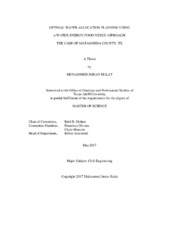| dc.description.abstract | Conventional methods for analyzing the influences of water planning decisions frequently miss the dynamic interconnections between water, energy, and food (WEF) resources. This study presents a platform to analyze the feasibility of possible interventions and recommend scenarios to enhance WEF resource sustainability. A water-centric framework includes a unique analytic tool for quantification of the tradeoffs for future scenarios consisting of interventions, and a sustainability analysis for drawing recommendations for future water allocation in light of WEF inter-linkages. The applied case is Matagorda County, which, despite ample water resources, is considered one of the most water stressed area of Texas due to high demands on water resources from agriculture and energy sectors.
The possible interventions mostly include water-related infrastructure such as building desalination plant, treatment facility, improving existing canal system, applying high-tech on-farm irrigation, changing cooling system of the nuclear plant, and building their conveyance systems. A great number of scenarios consisting of combinations of possible interventions are developed. The analytic tool produces quantitative parameters for each scenario. A sustainability analysis using the parameters produced by the tool enables presentations of advisable water, energy, food, environment, or cost -centric and optimal scenarios. The findings of the study present most sustainable combinations of water-related infrastructure that can protect primary resources as well as contribute economic well-being of Matagorda County. | en |


